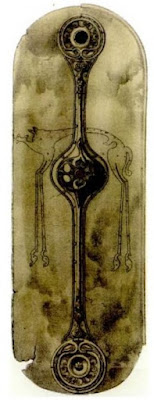 |
| Witham Bronze Shield |
 |
| Northamptonshire Helmet, Saxon 7th c. AD |
It is evident that boar images on helmets and shields point to the use of the wild boar, symbolically, as a protective symbol (whereas the wolf appears mainly on swords - see the WOLF post). From early times the boar was associated with battle, it was a fierce adversary in the hunt. In the Welsh story Culhwch and Olwen, the hero Culhwch tracks the renowned boars Ysgithyrwyn (Chief Boar) and Twrch Trwyth. The former to rip out its great tusk, the latter to claim the golden comb, razor and shears that were trapped in the bristles between the beast's ears (all this, amongst other tasks, for fair Olwen’s hand). Culhwch’s birth is interesting: his mother, Goleuddydd, went mad during pregnancy, shunning habitation and coming to her senses amidst a herd of pigs. Gripped by a terrible fear of the animals she delivered her child. Thus Culhwch was discovered sitting alone in the woods, on a pig-run.
 |
| These three boars were hand-carved by me many years ago. |
In reality the boar has a huge head, mounted on a powerful, muscular neck. Thus, when foraging for food, the boar can shovel into frozen earth for roots, tubers and bulbs. They have a varied diet, eating leaves, bark and seeds, shoots, garbage as well as worms, fish, rodents, snakes and frogs in the warmer seasons. Carbohydrates are important factor, helping to build up the fat reserves needed by the boar during hard times.
Throughout the span of Europe wild boars vary in size from a metre and half in length and standing about 80cm tall, weighing around 70-100KG (though their eastern european cousins are a little bigger). The males possess a ridge of back bristles tracing the length of their spine, which stands erect when the animal is agitated. If males are fighting they emit a high-pitched, harrowing cry ( like the Carnyx - see the video below). They are hardy animals, adapting to various climates and - as a bonus - they are immune to snake venom.
As regards their ferocity, attacks on humans are incredibly rare, however they are certainly not to be messed with. Their protruding tusks are razor sharp and they bowl through the undergrowth, capable of speeds of up to 40km/hour. Once the initial charge has sent the opponent spinning to the ground, the boar will step back, commencing to attack again until the target is unmoving.
A panel from the Gundestrup Cauldron
|
In myth boars appear as huge monstrous beasts, often luring their pursuers into the underworld. Their red-eyed visages adorned the carnyx, or battle trumpets of the Celts. More often than not the boar is portrayed with its dorsal bristles exaggerated, placing emphasis on their fierceness, or perhaps depicting that these are not animals of this world but of the otherworld: the ridges reflecting the way real animals react to death trauma. San shamen depict animals this way as an evocation of the spirit-animal.
Double boar design from Anglo Saxon burial at Sutton Hoo
|
Even into the 1800’s folk customs from Estonia, Swabia, Austria and Russia recorded numerous accounts of customs involving a Rye-boar or Corn-boar. An old custom in parts of Europe was to bake a yuletide bread in the form of a boar.
It appears from the multitude of these customs that the boar was involved in the idea of the sowing and reaping of the crop; in the cycle of growth and the harvest. Celebrations at Yule and Christmas involving boar effigies of straw or bread possibly replaced earlier sacrificial animals (in the Golden Bough, Frazer continually refers to this as evidence of a Corn-Spirit worship… perhaps forgetting that corn was only introduced into Europe in the 15th-16th centuries. However it might be indicative of some association between the wild boar and fertility with other grains, such as wheat). Boars were also associated with prosperity, not only for the harvest but as a source of food.
Many Celtic coins portray boars with grossly exaggerated dorsal ridges atop human profiles; as though reflecting some poignant connection between the head and the boar and may reflect states of altered consciousness. The idea that people could become animals and change states of Being is well attested in ancient myth (and this is a topic for another post).
The boar exists as force of nature. It lives in the forests and the wilds, occasionally straying to the periphery of human habitation. Thus they are ambassadors of that force, and the power of the wild. Their hardy, fierce aspect was something that Iron-age warrior tribes coveted. They are also protectors, their tough skins and hard bristles affording them a thick skin.
I've always enjoyed that inital scene from the Studio Ghibli film Princess Mononoke: when the primal sprit of the wild appears as a huge white boar, thundering through the forest. It's a great representation of the embodiment of Nature that the boar offers us. This glimpse into the past, a sort of reality check, from our domesticated world into that of the chaos of the wild.
An Archaeology Of Animals - Miranda Green
Symbol And Image In Celtic Religious Art - Miranda Green
The Golden Bough (Vol 2) - James George Frazer
Wikipedia
Wikipedia







